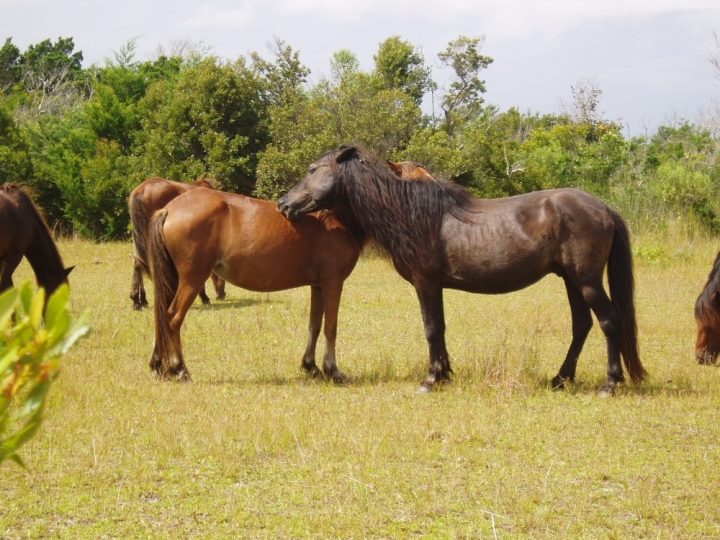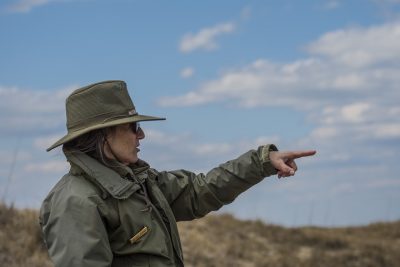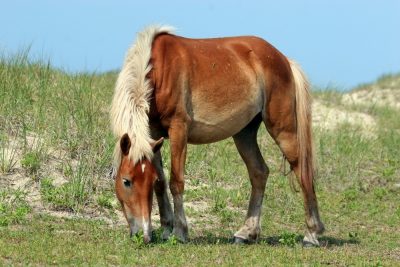
CAPE LOOKOUT NATIONAL SEASHORE – The population of wild horses that call Shackleford Banks home has increased from 2013 to 2017, despite the mortalities that occurred during the period, according to a recent report from the national park.
Included in the Aug. 17 Cape Lookout National Seashore Shackleford Banks Horses 2017 Annual Report, which covers the calendar year of 2017, are details of the population growth, mortalities, public education, partnerships and research as of Jan. 2.
Supporter Spotlight
Shackleford Banks is part of the 56 miles of barrier islands that make up Cape Lookout National Seashore. Found south of Beaufort and Harkers Island, on the southernmost island in the national park, the herd of wild horses that has roamed free for centuries is managed by the park and the nonprofit Foundation for Shackleford Horses.
The findings in the report reflect that the number of horses in the herd has increased from 2013 to 2017. The legislated target range is 120 to 130 horses. Since 2009 when the last birth control was administered for population reasons, the birth rate has been gradually rising. As of Jan. 2, the horse population was 120. When the report was released in August, the population was 119, including eight foals.

“With the legislated population range of 120 to 130, we’re right at the lower edge of that, which is a pretty comfortable place to be. Last year we had 14 foals, which if we have the same again this year, it would take us over the 130 but this year we’ve had eight so far, and we’ve also had some mortality,” park biologist Dr. Sue Stuska said.
For the most part, mortality is averaging 6 percent since they’ve been recording data.
“We determined that if we had between six and nine foals that should balance out mortality, which is what we want,” she said, adding contraception for the horses is used sparingly. “We’re looking at population range but shouldn’t have to contracept,” she said. “We do want foals every year.”
Supporter Spotlight
Among the mortalities was one adult female horse that died at age 25 and one female foal that died at less than a month old. Four adult males died at ages 20, 18, 15 and 14. The 14-year-old stallion died from complications from a lower leg wound.
Stuska said they are unsure of how the stallion was injured before it died but believe it was from a man-made object.
Stuska came to work at Cape Lookout in 1999 after she and her husband volunteered at the park while she was between academic jobs teaching equine technology science on the college level. She also has several years of experience working with domestic horses.
“We watched him carefully,” she said of the injured stallion. “The management policy is to treat these animals as wildlife,” meaning they do not interfere unless it’s an emergency and that’s on a case-by-case basis.
Visitors to the island spotted the horse limping and reported it to park officials. Stuska said that they had a hard time tracking the stallion down on the 3,000 acres where the horses roam. Then, someone reported that there was a wounded horse in the middle of the island.
“I didn’t realize until I saw that horse that he had been limping for a long time … that it’s been bad for a while,” he said.
She said she’s observed that the wild horses are far more resilient than domestic horses and heal quicker. “But after watching this particular horse for a period time, drawing on my experience from domestic horses that you can touch — which you can’t do that with these guys, you just have to watch them with binoculars, you can’t just go up and medicate them — when I saw his injury … it didn’t look like it was going to heal, in my professional judgement.”
Stuska said that they had a veterinarian look at the horse while sedated, “which we don’t do unless it’s really, really bad.” The sedation used on the stallion is what would be used for any kind of horse that’s difficult to handle, “but his system was in such bad condition, probably from the infection, he quietly slipped away,” she said. “He succumbed without euthanasia.”

As far as they could tell, she continued, the wound looked like he had stepped on something. “It’s only a guess, we don’t know what happened.”
The Cape Lookout staff works to keep the island clean and safe. “We’re trying to get trash off the island that would be dangerous to horses, birds, turtles, people and the ocean,” Stuska said, adding that construction debris often washes up on the island.
The park works with Carteret Big Sweep, an outreach program geared to educate the public about the hazards of litter and holds cleanups year-round, she added.
Stuska wanted to remind the public that they should observe the wild horses from a safe distance and to keep pets on a leash. “You definitely should not be close enough that there’s any way you or the horse could come in contact with each other,” she added.
“The horses have fascinating wild behaviors because, it’s a bunch of intact males with females – they’re not like domestic horses, they’re not gelded — so you’ve got this wonderful behavioral horse society out there, and we try to encourage people to sit back and watch the behaviors and use that as a way to be fascinated by them,” she said. “It’s a very civilized society … they’re just fascinating to watch.”
It is illegal to feed, touch, tease or intentionally disturb wildlife, including the horses. Call Cape Lookout National Seashore to report someone disturbing wildlife and take a photo. Anonymous tips may be left after hours.
Visitors should avoid interfering with the wild horses to prevent the herd from becoming habituated. Habituated horses and other wildlife can be a danger to humans and themselves.
The Wild Horse Public Education Campaign began in 2011 to help educate the public on interacting with the wild herd population. Cape Lookout National Seashore, the Foundation for Shackleford Horses, and the Rachel Carson Reserve on Carrot Island in Beaufort, which has a herd of about 30 wild horses, work together to educate the public about the horses with an emphasis on safety of the horses, park and reserve visitors and pets.







